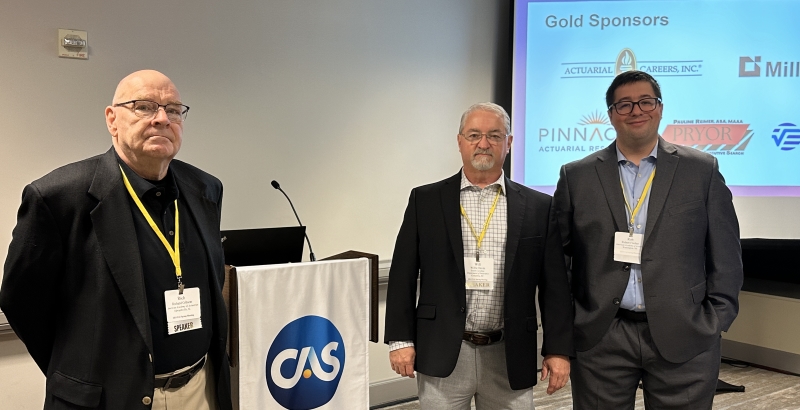Casualty Quarterly, Spring 2024
Vol. 8 | No. 2
Date:03/03/2024
A Deep Dive Into P/C RBC
WilkinsA May 1 webinar, An Introduction to P&C Risk-Based Capital, featured members of the P/C Risk-Based Capital (RBC) Committee, who gave historical background on RBC, noted recent developments, and detailed Academy work on this issue. Committee Chairperson Ron Wilkins, who moderated the webinar, offered some follow-up insights on the issue for Casualty Quarterly.
The webinar the committee hosted recently was highly informative. What jumped out to you (as someone who lives and breathes RBC!) as interesting questions, comments, or takeaways from the audience feedback? It was great to see the level of attendance and engagement at the webinar.
The questions from the attendees were great, covering a range of important RBC topics. It jumped out to me that many Academy members are quite interested in RBC and the role that it plays in helping regulators to identify potentially weakly capitalized insurers. One attendee asked about studying actual historical insolvencies and how RBC helps regulators identify undercapitalized companies. Another asked about whether RBC better enables regulators to identify struggling companies than Insurance Regulatory Information System (IRIS) tests, which are managed by the NAIC and are used to analyze the financial statements of insurance companies. These are questions that the committee will reflect upon in our work.
Can you explain what the P/C RBC Committee does and how you engage with the NAIC?
The committee monitors the performance of, and suggests enhancement to, the P&C RBC methodology used by the NAIC. The committee’s mandate includes the entire RBC formula, but we have put a lot of focus in recent years on reserve risk, premium risk, and catastrophe risk because those charges are the major drivers of RBC for most insurers.
There is also significant interaction between the Academy committee and the NAIC’s Property and Casualty Risk-Based Capital (E) Working Group. This close engagement with the NAIC is a really exciting aspect of being involved on the committee. We meet with NAIC counterparts monthly (or more often) to update them on ongoing research and to stay aware of regulatory priorities. The meetings give us a chance to ensure that the committee’s reports are fully understood by NAIC decision makers. In that interaction the volunteers on the committee can directly see the value of the unbiased actuarial analysis which is key to keeping the RBC formula up to date.
Why is RBC public in the 5-year exhibit but private in RBC submissions?
Total adjusted capital (TAC) and authorized control level RBC have been included in the Five-Year Historical Data exhibit of the Annual Statement since the initial roll out of P&C RBC in the 1990s. Capital requirements prior to the introduction of the P&C RBC formula were flat minimum amounts unrelated to risk-i.e., they did not differentiate by company size, exposure characteristics, or risk. My understanding is that at the time that the P&C RBC formula was rolled out, the regulators involved felt that disclosing the overall result of the calculation would give stakeholders more confidence in the RBC formula, especially since it was a large advancement compared to the earlier approach and was much more complex than the earlier approach.
Since then, RBC and TAC have been published for each carrier each year. Recently, discussions among regulators and interested parties related to the purposes of RBC have introduced the idea of removing these items from the NAIC Annual Statement. There is some concern that RBC could be used inappropriately (e.g., to compare well-capitalized companies, to promote companies, etc.). On the other hand, insurance purchasers might benefit from seeing the RBC and TAC of potential carriers. In contrast, the overall RBC submission is kept confidential for each insurer because it contains data for key risks which is more detailed than the NAIC Annual Statement data. For example, the confidential RBC submission contains historical loss experience and modeled tail losses for hurricanes and earthquakes.
Does the Committee look at actual insolvencies and the RBC prior to insolvency to see if the pre-insolvency RBC was predictive?
To my knowledge, the committee has not yet done a study of actual insolvencies. However, we think that such a study could be helpful in identifying potential improvements to the RBC formula and so we intend to consider undertaking such a study in the future.
Did any adjustments to RBC calculations during the past few years need to be made in connection with COVID?
The committee’s August 2023 Report on Underwriting Factors and Investment Income Adjustment Factors used insurance industry data evaluated through 2017 and used economic data through June 30, 2023. Substantial work is involved in data preparation for the insurance data used in the analysis. The analysis was one of three analyses described in the committee’s May 2019 letter to the NAIC and we felt it would be beneficial to produce the three reports with the same insurance data. The 2023 report considered data from Accident Years 1980-2017, so the effect of adding a small number of years would likely have been low.
In future committee calibration work we will incorporate insurance industry data through at least year-end 2023, which will allow us to reflect the impact of COVID-19 on loss ratios and reserve development. Such work will need to proceed thoughtfully. It would be important for future calibrations to reflect changes related to COVID which are likely to have lasting impact, for instance changes in policy wording related to business interruption, while COVID impacts which were idiosyncratic, such as the temporary significant reduction in miles driven, should not be brought into the RBC formula.
What projects are the committee currently focused on?
The committee is currently working on a report on diversification by line of business for reserve risk and premium risk (this will be the third of three reports outlined in the May 2019 letter to the NAIC). Currently, the RBC formula provides for a maximum diversification credit of 30% for multi-line carriers for reserve risk and premium risk and this research project aims to update the calibration of the maximum diversification credit.
Another active topic for the committee is considering inclusion of the wildfire peril in RCATRCAT-the catastrophe risk component of the RBC formula, described further in the committee’s 2023 report-and corresponding adjustments to premium risk charges to avoid double counting that peril. Additionally, the committee is initiating work to update the calibration of reserve and premium risk charges to reflect more recent insurance experience. In so doing, the committee is exploring ways to improve the efficiency of the risk charge calibration computations.
Interested in volunteering? The P/C RBC Committee is always open to new members. If you are interested in volunteering on any of the committee’s long-term projects, please reach out to Casualty Policy Analyst Rob Fischer at fischer@actuary.org.
‘Hill Visits’ Offer Academy Perspective on Key P/C Issues Including Cyber, Climate
Academy casualty staff and volunteers met with federal policymakers in Washington, D.C., in mid-April for their annual “Hill visits,” discussing key public policy issues and sharing relevant Academy resources on topics including cyber and climate risk, health insurance markets, AI, and financial reporting and solvency.
“The Hill visits provide a unique opportunity to answer pertinent questions, provide data-based insights, and be a general resource to policymakers,” said Sam Tashima, vice chairperson of the Academy’s Committee on Cyber Risk and a 2023 Rising Actuary Award recipient.
“In particular, the cyber insurance field continues to be ever evolving, and there are a variety of stakeholders such as the Federal Insurance Office, Congressional Research Service, and Office of the National Cyber Director that all have interests in the latest trends from the cyber insurance industry,” Tashima said. “We were able to provide our expertise and knowledge around these subjects to help inform and lend our viewpoints.”
The Academy distributed business cards with QR codes, which offered policymakers’ staff links to key practice-area work, initiatives, and upcoming events and webinars; staff and volunteers will continue to work with stakeholders on ongoing and new initiatives.
L-R: Casualty volunteers Sam Tashima, Isabelle McCullough, Katie Koch, and Wanchin Choi on Capitol Hill
The visits presented an opportunity for the Academy to offer its unbiased, nonpartisan, objective perspectives on key issues with elected officials and staff-particularly valuable during a presidential election year.
P/C cyber volunteers’ meetings included a discussion with the White House Office of the National Cyber Director. Conversations over the two days focused on the most effective cyber-risk mitigation techniques, understanding data availability and limitations, and the Academy’s Cyber Risk Toolkit.
Casualty volunteers were joined by members of the Risk Management and Financial Reporting Council (RMFRC), who shared insights on issues including flood insurance and climate issues, as well as big data and AI, said Seong-min Eom, RMFRC’s immediate past vice president.
“Climate-change issues aren’t limited to floods or fires, but can also affect access to health and life insurance,” she said. The Climate Change Joint Committee, which Eom chairs, is working on a paper on financial inequities caused by climate-related disasters affecting all practice areas, but not impacting all communities equally, which also drew interest from policymakers during the visits.
Academy Presents at CAS Spring Meeting
(L-R) Senior Casualty Fellow Rich Gibson, S.C. Department of Insurance P/C Actuary Will Davis, and Casualty Policy Analyst Rob Fischer, at CAS
The Casualty Actuarial Society’s (CAS) Spring Meeting, held in Atlanta in early May, featured a presentation from Academy Casualty Policy Analyst Rob Fischer, Senior Casualty Fellow Rich Gibson, and Will Davis of the South Carolina Department of Insurance, on current and future P/C public policy considerations.
President Lisa Slotznick and Executive Director Bill Michalisin represented the Academy at the event, and Board member Dorothy Andrews participated in the panel “Breaking Down Bias in Data & AI.” Committee on Cyber Risk Chairperson Wanchin Chou participated in a session focused on how regulators evaluate catastrophic risk.
Attendee volunteers also filled bags for Atlanta-area elementary school students, which included copies of the Academy’s The Magic School Bus Takes a Risk: A Book about Probability, which is available for order.
Nominations Open for Academy Member-Selected Directors, Annual Awards
Nominations are open for Academy member-selected directors (MSDs) and are due on June 3. MSDs will serve three-year terms on the Board of Directors. Nominated candidates will be selected by Academy members later in 2024 in an online selection process from the slate of candidates presented by the Nominating Committee. To learn more and to nominate, visit the MSD Nominations page.
Nominations are also open for the Academy’s annual service and recognition awards. To submit nominations for the Jarvis Farley Service Award, Robert J. Myers Public Service Award, Outstanding Volunteerism Awards, and Rising Actuary Awards-being accepted through June 7-visit actuary.org/awards. Recipients will be recognized at Envision Tomorrow, the Academy’s Annual Meeting, in October.
Academy Presents on P/C Issues at NAIC Spring Meeting
L-R: ASB Chairperson Kevin Dyke, Gibson, Fischer, Academy President Lisa Slotznick, CAS President Frank Chang, and Committee on Cyber Risk Chairperson Wanchin Chou at NAIC
Academy P/C staff and volunteers presented on casualty and professionalism and issues and engaged with stakeholders from other organizations at the National Association of Insurance Commissioners (NAIC) Spring National Meeting in Phoenix in mid-March.
Post-NAIC Spring Conference Recap: Hot Topics from Phoenix, now available on-demand, features Casualty Policy Analyst Rob Fischer and other public policy analysts recapping meeting highlights and look ahead to issues likely to be discussed at NAIC’s Summer National Meeting, set for Chicago in August.
Academy professionalism presentations included President Lisa Slotznick, who presented on behalf of the Academy and the Committee on Qualifications to NAIC’s Life Actuarial (A) Task Force (LATF), Health Actuarial (B) Task Force (HATF), and Casualty Actuarial and Statistical (C) Task Force (CASTF). Actuarial Standard Board (ASB) Chairperson Kevin Dyke presented on behalf of the ASB to present to HATF and CASTF, and ASB Co-Vice Chairperson Laura Hanson presented to LATF.
Casualty presenters included Fischer, who gave an update to CASTF on Casualty Practice Council (CPC) activity, including anticipated releases from other CPC workstreams of interest; and Senior Casualty Fellow Rich Gibson, who gave an overview of cybersecurity issues, including the Cyber Risk Toolkit.
New Academy Election Site Focuses on P/C, Public Policy Issues
The Academy launched Election 2024: Issues Clearinghouse, a microsite housed on the Contingencies website that’s focused on six key public policy “mega-issues,” including several P/C issues, climate change and cybersecurity. Also covered are health care, retirement security, AI, and risk management.
Actuarially Sound-The Academy’s new Actuarially Sound blog offering deep dives into issues as they arise this presidential election year. It will share the actuarial profession’s independent and informed insights on these large issues, with a specific focus on those issues that will likely influence what elected officials do in the next four years.
CLRS, P/C Loss Opinion Seminar Coming Later This Year
The Academy is sponsoring two P/C events being held later this year:
The Academy and CAS are sponsoring the Casualty Loss Reserve Seminar (CLRS), set for Sept. 9-11 in San Francisco. Visit the CLRS webpage for updates.
The Academy’s Seminar on Effective P/C Loss Reserve Opinions will be held Dec. 9-10 in New Orleans. Called by one past attendee “a great distillation of changing requirements and rules, as well as a good pooling of experience,” the seminar is designed for P/C actuaries who prepare or assist with preparing NAIC annual statements of actuarial opinion on P/C loss reserves. Save with early registration-register today.
Academy Provides Climate Overview to German Actuarial Association
Director of Research (Public Policy) Steve Jackson and Peter Ott, chairperson of the ACI/ACRI (Actuaries Climate Index / Actuaries Climate Research Index) Working Group and a vice chairperson of the Climate Change Joint Committee, delivered a March 14 virtual presentation to the German Actuarial Association, “U.S. Actuarial Societies & the American Academy of Actuaries’ Climate Work.”
Casualty VP Angell Offers Professionalism Outreach
In an April 19 virtual presentation to the Spring meeting of Ohio Casualty Actuarial Society affiliate group Buckeye Actuarial Continuing Education, Academy Casualty Vice President Amy Angell highlighted the meaning of self-regulation, the professionalism framework for U.S. actuaries housed in the Academy, and developments in casualty and cross-practice actuarial standards of practice (ASOPs) and at the Actuarial Board for Counseling and Discipline.
Interested in an Academy Speaker?-The Academy provides qualified speakers to actuarial clubs and organizations to help members fulfill their professionalism continuing education requirements and become more informed on public policy issues. To request a speaker, visit the Academy website.
Webinar Examines Bias in P/C Insurance
A March 5 webinar, Bias in P/C Insurance: Updates from the Committee on Equity and Fairness, featured members of the committee, who presented on the regulatory outlook in Colorado and Washington, D.C. Slides and audio are available as a complimentary member benefit.
Reminder-Comments on ASOP No. 7 Due June 1 A reminder that comments on ASOP No. 7, Analysis of Life, Health, or Property/Casualty Insurance Cash Flow Risk, are due to the Actuarial Standards Board (ASB) by June 1. For a deep-dive Q&A on the ASOP, which affects P/C and other practice areas, see the January Professionalism Counts. To comment, see the exposure draft on the ASB website.
A reminder that comments on ASOP No. 7, Analysis of Life, Health, or Property/Casualty Insurance Cash Flow Risk, are due to the Actuarial Standards Board (ASB) by June 1. For a deep-dive Q&A on the ASOP, which affects P/C and other practice areas, see the January Professionalism Counts. To comment, see the exposure draft on the ASB website.
Highlights From Casualty Quarterly 
Prefer to watch your news? Check out this “Highlights From Casualty Quarterly” video for a quick recap of what you need to know.
Member Spotlight-
Casualty VP Amy Angell
Read the latest Academy “Member Spotlight” to learn more about Academy Casualty Vice President Amy Angell and her experience as an Academy volunteer and Board member. Visit the Member Spotlight page to read more about Angell and her love of sculpture and the outdoors.
In the News
An Insurance Journal article on the increasing potential scope of systemic cyber events led with remarks by Immediate Past Chairperson and current member of the Committee on Cyber Risk, Norman Niami.
Inside Nova and more than 70 other outlets around the country cited the jointly sponsored Actuaries Climate Index in an article about travel insurance.
InsuranceNewsNet covered Academy Board member and Data Science and Analytics Committee Chairperson Dorothy Andrews’ presentation, “Where Does Bias Hide? Defining Data Biases and Unfairly Discriminatory Considerations,” to the NAIC’s Casualty Actuarial and Statistical Task Force’s February book club webinar.
Legislative/Regulatory Activity
Federal
President Biden signed an executive order authorizing federal action to protect Americans’ personal data from exploitation by international actors. Among the recommendations is direction to the attorney general to develop regulations to establish clear protections while also working collaboratively with the Department of Justice and the Department of Homeland Security to prevent the large-scale transfer of Americans’ personal data to countries of concern in an effort to halt access to Americans’ sensitive data.
The Office of Management and Budget issued a government-wide policy establishing new agency requirements and guidance for AI governance, innovation, and risk management in an attempt to mitigate threats posed by AI. To address these threats, which include discrimination and privacy violations, as well as increase transparency over how government uses the technology, federal agencies will be required to implement “concrete safeguards” by Dec. 1.
A federal district court in Illinois upheld a rule by the Housing and Urban Development outlining a test to determine whether homeowner’s insurance has a disparate impact on minorities under the Fair Housing Act. The original 2013 rule was challenged by the American Property Casualty Insurance Association, which argued that HUD didn’t adequately consider the issues at stake before promulgating the regulation. The same district court then vacated the rule, which was subsequently revised and republished in 2023.
The House Financial Services Committee passed HR 7462, the Wildfire Coverage Study Act. The legislation requires the Government Accountability Office to study insurance coverage for damages from wildfires, including the state of wildfire risk, as well as the events that have triggered higher homeowners and commercial property rates and certain insurance policy non-renewals.
The Senate Banking, Housing, and Urban Development Committee held a hearing for S 2142, the National Flood Insurance Program Reauthorization and Reform Act (NFIP). The bill revises the NFIP and reauthorizes the program through fiscal year 2026. It addresses NFIP coverage, cost, and availability and prohibits the Federal Emergency Management Agency (FEMA) from raising premiums, surcharges, and fees by more than 9% a year for five years.
State
Kentucky Gov. Andy Beshear signed HB 256, establishing the Strengthen Kentucky Homes Program. The program requires property insurance companies to provide a premium discount for properties that receive a qualifying certificate of compliance and permits the state insurance commissioner to issue regulations establishing standard discount amounts and benchmarks for coverage.
Indiana Gov. Eric Holcomb signed HB 1332 on March 13, making several changes to the state’s insurance laws, including the adoption of the National Association of Insurance Commissioners’ (NAIC) regulation dealing with liquidity stress testing. It also requires insurers to mail a written notice of nonrenewal to local government customers at least 60 days before terminating a policy.
South Dakota Gov. Kristi Noem signed similar legislation, HB 1059, implementing the NAIC’s liquidity stress test framework.
The Hawaii House of Representatives approved SB 3234, addressing the financial standing of the Hawaii Hurricane Relief Fund and the Hawaii Property Insurance Association. The proposed legislation imposes several taxes and fees on property transactions and mandates that both the relief fund and the insurance association are insurers of last resort in the state. It also passed SB 3344, creating the Hawaii Wildfire Relief Fund and Hawaii Wildfire Relief Fund Corporation to compensate those suffering property damage from catastrophic wildfires in the state.
Louisiana Rep. Edmond Jordan introduced HB 673, barring unfair discrimination in insurance practices and prohibiting the use of external consumer data and information sources, as well as algorithms and predictive models using external consumer data and information sources, to ensure fair and equitable access to insurance offerings.
Arizona Gov. Katie Hobbs signed HB 2729, changing the minimum primary commercial liability insurance coverage for both transportation network drivers and taxi and limousine drivers to $1,000,000 per incident.
Maine’s LD 2225 became law without the signature of Gov. Janet Mills. It requires that home sellers notify buyers if the property is located within a special flood hazard area mapped by the Federal Emergency Management Agency.
Maryland Gov. Wes Moore is considering SB 806 / HB 738, which deal with liability insurance for home improvement contractors, increasing the amount of general liability insurance they must maintain from $50,000 to $500,000. Moore also signed SB 216, raising the penalty for employers who fail to obtain required workers’ compensation insurance from $10,000 to $25,000.
The Maryland Senate approved HB 647, legislation establishing requirements and prohibitions for pet insurance policies issued in the state, including disclosure rules and wellness program requirements, and mandating that the Maryland Insurance Administration develop informational materials about pet insurance policies by June 1, 2025.
The Colorado General Assembly approved HB 24-1060, a bill adopting, in part, the NAIC’s travel insurance model act, which provides a legal framework for the sale of travel insurance in Colorado.
The Florida Senate passed HB 293, requiring homeowners’ associations to adopt hurricane protection specifications that conform to building codes. The law also prohibits homeowners’ associations from denying applications to install certain hurricane protection elements.
Georgia Gov. Brian Kemp is reviewing reinsurance-related legislation, HB 1049, which addresses limitations in the current methods available to insurers in the state to transfer or assume blocks of insurance business in an efficient and cost-effective manner.
Washington Gov. Jay Inslee signed HB 1899, creating a disaster relief payment program to provide assistance to qualifying property owners and local governments affected by two wildfires that damaged or destroyed more than 750 buildings in Spokane County last August.
Virginia Gov. Glenn Youngkin signed HB 205, which bars an employer or workers’ compensation insurance carrier from seeking to recover a payment made to a health care provider for services rendered to a claimant unless it is sought less than a year after the payments made.
Oregon Gov. Tina Kotek signed SB 1580, making it a crime for an employer to file a false payroll report to lower their worker’s compensation insurance premium.
West Virginia Gov. Jim Justice signed HB 5178, requiring care dealerships in the state to determine if buyers of vehicles have valid motor vehicle insurance.
Casualty Public Policy in Brief
The P/C Extreme Events and Property Lines Committee submitted a comment letter to the California Department of Insurance in advance of the department’s public workshop on its draft regulation that would modify state law to allow for catastrophe modeling to be used for wildfire, terrorism, and flood lines of homeowners and commercial insurance lines.
The casualty, health, and life practice councils sent a comment letter to the New York State Department of Financial Services on a proposed circular letter on the use of Artificial Intelligence Systems and External Consumer Data and Information Sources in insurance underwriting and pricing. The councils wrote that they appreciate the department’s acknowledgment and reliance on actuarial standards of practice throughout its effort.
The Casualty Practice Council submitted comments to the ASB on the proposed revision of Actuarial Standard of Practice ASOP No. 12, Risk Classification (for All Practice Areas).
Norman Niami, immediate past chairperson of the Committee on Cyber Risk, discussed the Cyber Risk Toolkit, the latest issues surrounding assessment and data tracking of this risk, and other topics as a panelist in a March 19 Insurance Journal webinar, Weathering the Storm: Cyber Risk in 2024.